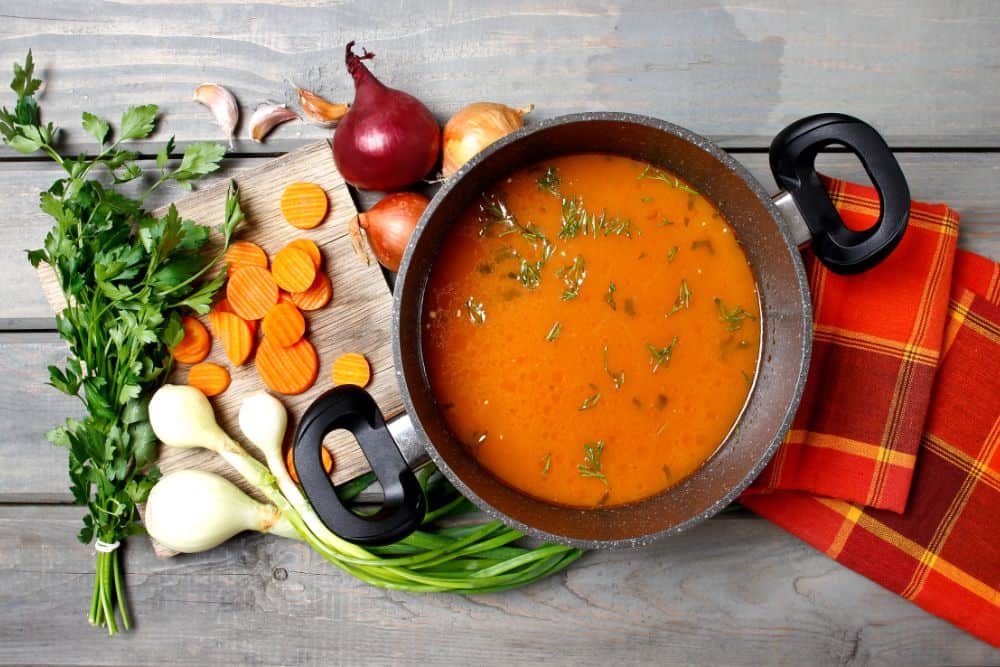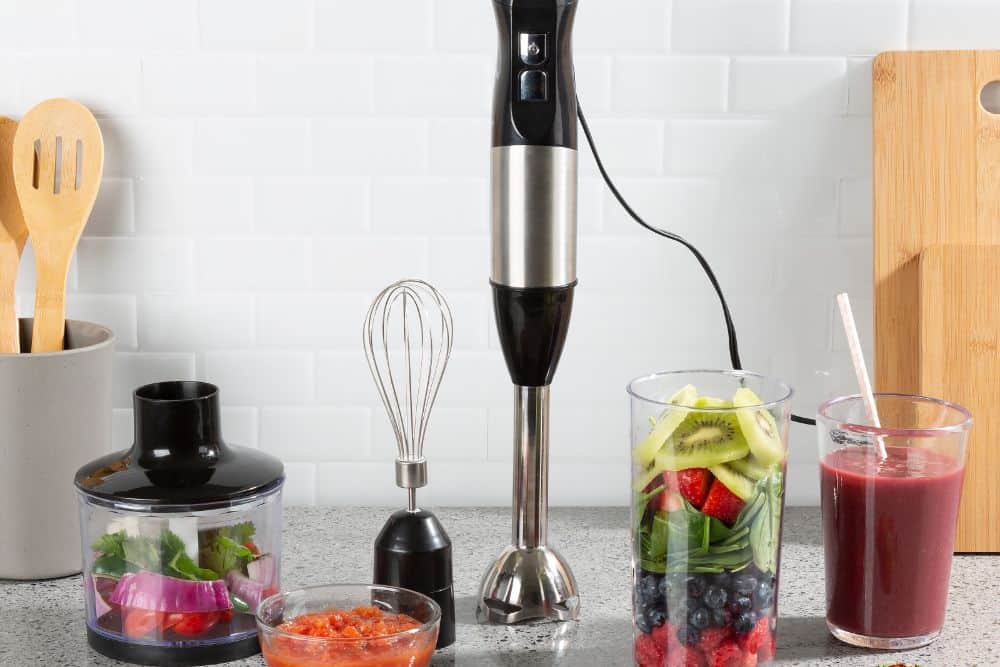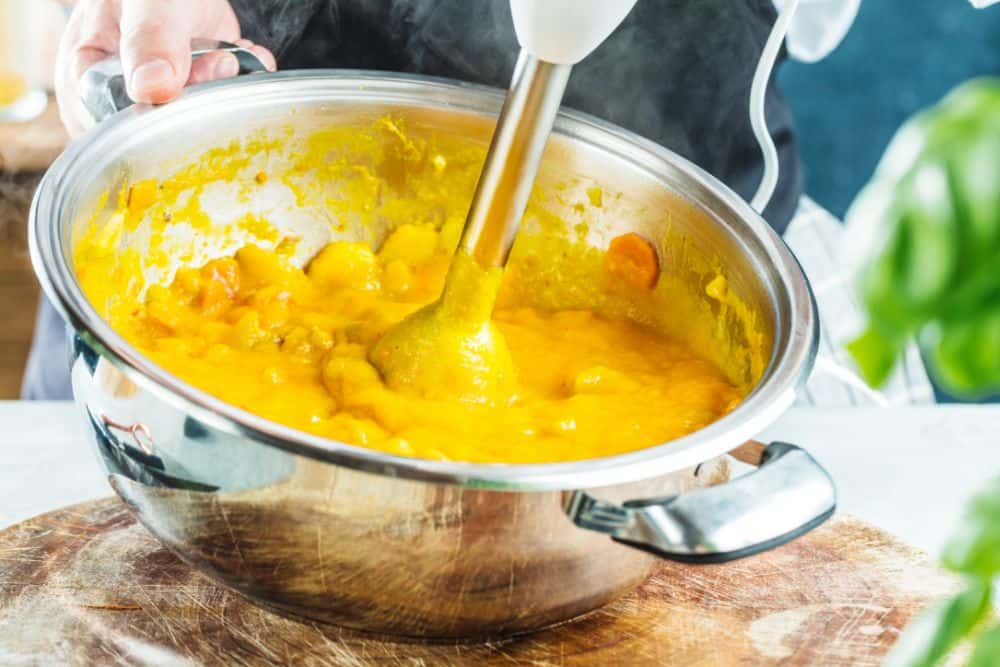Few dishes are simultaneously comforting and elegant as a puree, bisque or hot soup. Yet, professionals make it look so easy all the time on those addictive cooking shows. Then, on special occasions, you come across a restaurant with one such delectable offering. Then recipes tempt you to try to recreate the dish at home. Yet, fewer dishes are as hazardous for the at-home cook to make. Except for anything flambeed.
Hot liquids have two potentially dangerous characteristics; heat and steam. Boiling fluids are generally thinner than colder liquids. The vortex created by the blending blade causes the fluid to push higher on the sides of the canister. The steamy hot liquid can generate more than enough pressure to force the lid off the blender jar, spewing the contents onto the cabinets, countertops, and floors.
Not to mention the painful and potentially scarring burns that could cover your arms, face, and chest. Working with hot soups under the wrong conditions could be life-altering.
So, how do you safely use a blender to blend hot liquid?
By using the correct tools and closely following safety precautions, you can safely use a blender to blend hot soups at home.

Blending Hot Liquids Like This Soup Must be Done with Caution
Using the correct technique and equipment is the key to executing professional-level dish creation, especially when you want to obtain the silky smooth texture for which purees and bisques are known.
Which kitchen appliance is right for the job?
Some, but not all, blenders are rated for use with hot, not boiling, liquids. You can even find a food processor that is rated for blending hot liquids. And many professional chefs use immersion blenders, stick blenders, and handheld blenders in their kitchens. Be sure to read the manufacturer's specs, features, and user manual to make sure the machine can handle the hot ingredients.

Immersion Blenders Can be a Good Choice for Blending Hot Liquids
Before addressing safety concerns, let’s look at which appliances and tools are suitable for the tasks. You will want to consider a few things before making your selection:
Will the blender be solely for hot foods, or will it be used for frozen beverages and crushing ice?
What is the volume of food processing the blender will need to be able to handle?
Do you need an extremely powerful blender in order to meet your blending requirements?
How large of a countertop blender do you need for the type of cooking you plan to do?
Do you prefer pre-programmed one-touch control options or a professional-grade blender's more precise manual features?
To what temperature can the canister handle warm or hot liquids?
Consumer Report, the Gadget Review, and Good Housekeeping have reviews on blenders that are up to the task of blending hot foods. Vitamix, the Ninja blender, and Oster brands' full-sized blenders will heat liquids by friction alone.
Some models will cook the foods before blending. Others are professional-grade with precise manual controls. Several models have a full range of temperature capabilities, so you can puree the perfect bisque and mix the best margarita with the same machine.
Different blenders can be rated for different heat temperatures. For example, some machines, such as Ninja, can be used only with liquids at 180 degrees Fahrenheit or 82 degrees Celcius. Yet other blenders, like Pampered Chef or KitchAide, are rated to 220 degrees Fahrenheit or about 104 degrees Celcius. To err on the side of caution, use the thermometer to ensure the soup is at the correct, safe temperature for the machine.
Professional-quality blenders typically have large capacity containers, which are perfect if you make a lot of soup for a dinner party or a large family, the size will take up a significant amount of countertop space. If you do not need anything huge, look for a personal-size option with a rating for hot liquids.
KitchenAid has highly-rated deluxe cooking blenders. These blenders have a feature that allows you to slow cook your food and blend it automatically at the end of the cooking process. In addition, the capacity canister makes it great for family meals.
To save a step or two, you may want to consider a handheld immersion blender. Immersion blenders are versatile because they can blend liquid into the pot. No need to risk burns or creating a mess by transferring the soup from the stockpot to the blender to be processed.
Good Housekeeping, Buyers Guide, and Gadget Review rate Breville Control Grip Immersion Blender at the top of their lists. The top brands and models of immersion blenders have different attachment and control options. Most of the blenders boasted ergonomic handle designs. All-Clad’s cordless rechargeable hand blender eliminates the possibility of getting a cord into your food.

An Immersion Blender Blending Hot Liquid and Vegetables
One drawback immersion blenders have when compared with countertop blenders is their motor. Immersion blenders’ motors are generally not as strong as traditional blenders, and they can overheat if used for an extended period. However, a handheld blender should work fine if the foods you blend are soft.
Now that you have selected the best blender for your hot liquids processing needs let's look at some critical safety tips.
Refer to the blender’s owner’s manual to make sure your machine can handle what you are about to make it do. Keep the booklet in a handy location to ensure appropriate usage. The manufacturer will include any other special instructions as well as the maximum temperature the liquid can be for the integrity of the canister. If you have misplaced the manual, you should be able to find a PDF version online.
When pureeing hot liquids, work in batches. Yes, this will take some time, but it is the safest way to blend hot soups.
Allow the food to cool slightly for 3 to 5 minutes. Use a thermometer to ensure the liquid is not too hot for the container.
Use a ladle to transfer the hot food into the blender. Work slowly to prevent sloshing and splashing, keeping the mess down to a minimum.
Fill the blender canister no more than halfway. If the machine you use can work with hotter liquids, do not fill it more than one-third of the way full. Leaving a good bit of space will lessen the pressure built up by the steam.
Loosen the center cap of the blender lid, or remove it altogether to release pressure created by the steaming liquid. The pressure from the steam and vortex created by the blades will naturally seek a way of escape, violently if need be. The pressure and steam can be safely dispensed with the center cap loosened or removed.
Cover the lid with a folded dishcloth or two, and hold down the top while blending hot ingredients and hot liquids. The cloth will not create an airtight seal, which is a good thing. The folded dishcloths will prevent liquids from splashing out of the canister and protects you from burns and scolding. You will want to pre-treat and launder the cloth quickly to prevent stains.
Carefully pour the puree into another pot and repeat the process until all of the soup has been pureed. Do not place your hand directly on the blender canister or base, as the residual heat could burn your skin.
Reheat the soup before serving. In the meantime, clean the blender as instructed by the manufacturer. The starches generally found in the ingredients for most purees and bisques will become more challenging to clean as it dries.
The beauty of a handheld immersion blender is one less item to clean. As with the blender, refer to the owner’s manual for proper operating procedures.
When using an immersion blender in a pot of hot liquid, allow the liquid to cool for 3 to 5 minutes. Do not blend boiling liquids because the liquid could splash out and cause severe burns. This cooling will help lessen the amount of steam released during the blending process. You will be holding the machine over the pot, and a few degrees difference will make a lot of difference on your skin.
Since you are working over a hot pot, you may want to consider using an oven glove or something else to protect your hand from the heat. You will want to use something that is comfortable and will still allow you to have control over the blender.
Some immersion blenders have attachments to guard against the liquid splashing out.
If the brand of blender you have does not have a splash guard, you could make a guard with a thick paper plate by cutting a slit halfway through and cutting a circle to fit closely to the neck of the blender.
Once you have the texture as silky and smooth as you want, reheat the soup before serving.
Clean the blender as quickly as possible, following the manufacturer’s instructions.
Learning how to safely use a blender to blend hot liquids is crucial. Velvety bisques and purees require special skills and great care to be produced safely. Hot liquids cannot be treated the same as colder fluids or even ice. But, you can safely blend hot liquids in a blender if you follow these simple yet essential tips and rules.
